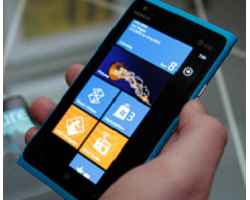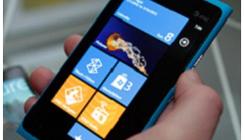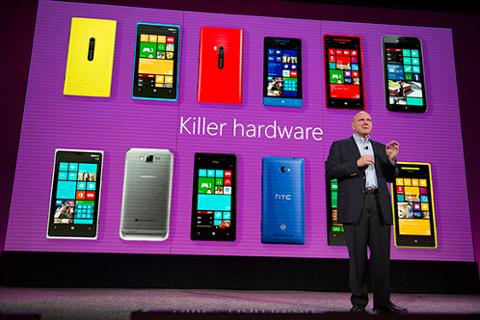 Microsoft announced late Monday plans to buy Nokia's devices and services business in a $7 billion cash deal, a move that not only aims to give the software giant Nokia's smartphone and mobile business but could set the stage for a new CEO at the Redmond giant. Under the deal, which is expected to close in the first quarter of 2014, Microsoft will pay 5.44 billion Euros for virtually all of its partner's Devices and Services business, in addition to licensing Nokia's patents and receive use of its mapping services. But perhaps the greatest win for the software giant may ultimately come in the form of a new CEO for Microsoft, which less than two weeks ago made a surprise announcement that its current top dog, Steve Ballmer, would retire in the next 12 months. A potential heir apparent could very well be Nokia's CEO Stephen Elop, a former Microsoft executive himself.
Microsoft announced late Monday plans to buy Nokia's devices and services business in a $7 billion cash deal, a move that not only aims to give the software giant Nokia's smartphone and mobile business but could set the stage for a new CEO at the Redmond giant. Under the deal, which is expected to close in the first quarter of 2014, Microsoft will pay 5.44 billion Euros for virtually all of its partner's Devices and Services business, in addition to licensing Nokia's patents and receive use of its mapping services. But perhaps the greatest win for the software giant may ultimately come in the form of a new CEO for Microsoft, which less than two weeks ago made a surprise announcement that its current top dog, Steve Ballmer, would retire in the next 12 months. A potential heir apparent could very well be Nokia's CEO Stephen Elop, a former Microsoft executive himself.
Elop's Return
 Stephen Elop, Nokia CEO[/caption] Elop, Nokia's CEO for the past three years, jumped to the Finnish mobile handset maker after having worked at Microsoft for several years running its business division that was largely responsible for Microsoft Office. During his tenure at the Redmond giant, Elop was well respected. At Nokia, Elop managed two notable wins – establishing an extremely tight mobile partnership with Microsoft in early 2011, and moving the struggling device maker into a sleeker smartphone line called Lumina that embraced software over hardware to a far greater degree than Nokia's previous CEOs. And although Nokia still clearly continues to struggle – its share price is roughly half of what it was before Elop joined the company and its Lumia smartphone lineup has yet to take consumers by storm – a couple signs seem to point to Elop as a potential front runner for the Microsoft CEO slot.
Stephen Elop, Nokia CEO[/caption] Elop, Nokia's CEO for the past three years, jumped to the Finnish mobile handset maker after having worked at Microsoft for several years running its business division that was largely responsible for Microsoft Office. During his tenure at the Redmond giant, Elop was well respected. At Nokia, Elop managed two notable wins – establishing an extremely tight mobile partnership with Microsoft in early 2011, and moving the struggling device maker into a sleeker smartphone line called Lumina that embraced software over hardware to a far greater degree than Nokia's previous CEOs. And although Nokia still clearly continues to struggle – its share price is roughly half of what it was before Elop joined the company and its Lumia smartphone lineup has yet to take consumers by storm – a couple signs seem to point to Elop as a potential front runner for the Microsoft CEO slot.
Chosen One?
For starters, the timing of Microsoft's Ballmer retirement announcement and the Nokia deal is peculiar. This mega-billion dollar acquisition likely didn't happen overnight and was probably in the works long before the Ballmer retirement announcement was made less than two weeks ago. The Wall Street Journal, for example, said the companies were in merger talks in June but talks stumbled over price. Secondly, to launch a CEO search for a Fortune 500 company is difficult, but to find a new CEO while simultaneously merging two large organizations is extreme. The Nokia deal is expected to close by March and, five months later, Ballmer is expected to step down. Also, why would Elop be willing to step down as Nokia CEO, a Fortune 500 company with brand name recognition, and assume a high-profile yet lessor role as executive vice president of Devices and Services at Microsoft? Additionally, executive recruiters and companies note that it is not unheard of to buy other businesses for their talent. Facebook, Google and other Silicon Valley titans, for example, have purchased startups just to grab their engineers and founders, notes a New York Times article. In the case of Microsoft, Elop will report to Ballmer and lead its expanded Devices team, which will include the company's devices and studio work, as well as its sourcing, customer logistics and supply chain. He will also be responsible for overseeing most of the teams coming over from Nokia. The handset maker expects to transfer approximately 32,000 employees to Microsoft, including 4,700 workers in Finland and 18,300 who work worldwide in manufacturing, assembly and product packaging. Although Microsoft and Nokia will need both shareholder and regulatory approval to complete the transaction, which is expected to happen in the first quarter, it won't be surprising to see Elop named Microsoft CEO once those hurdles are crossed -- but not before.
In Ballmer's Own Words to Employees
From: Steve Ballmer To: MS FTEs Date: Sep. 2, 8:00 PM PDT (Sep. 3, 6:00 AM EET) Subject: Accelerating Growth We announced some exciting news today: We have entered into an agreement to purchase Nokia’s Devices & Services business, which includes their smartphone and mobile phone businesses, their award-winning design team, manufacturing and assembly facilities around the world, and teams devoted to operations, sales, marketing and support. For Microsoft, this is a bold step into the future and the next big phase of the transformation we announced on July 11. We are very excited about the proposal to bring the best mobile device efforts of Microsoft and Nokia together. Our Windows Phone partnership over the past two and half years has yielded incredible work - the stunning Lumia 1020 is a great example. Our partnership has also yielded incredible growth. In fact, Nokia Windows Phones are the fastest-growing phones in the smartphone market. Now is the time to build on this momentum and accelerate our share and profits in phones. Clearly, greater success with phones will strengthen the overall opportunity for us and our partners to deliver on our strategy to create a family of devices and services for individuals and businesses that empower people around the globe at home, at work and on the go, for the activities they value most. We have laid out Microsoft’s strategic rationale for this transaction in a presentation that I encourage you to read. This is a smart acquisition for Microsoft, and a good deal for both companies. We are receiving incredible talent, technology and IP. We’ve all seen the amazing work that Nokia and Microsoft have done together. Given our long partnership with Nokia and the many key Nokia leaders that are joining Microsoft, we expect a smooth transition and great execution. As is always the case with an acquisition, the first priority is to keep driving through close, which we expect in the first quarter of 2014, following approval by Nokia’s shareholders, regulatory approvals, and other closing conditions. But I also know people will have some questions about what happens post-close. While details aren’t final, here is what we know, and how we’re generally approaching integration: 1. Stephen Elop will be coming back to Microsoft, and he will lead an expanded Devices team, which includes all of our current Devices and Studios work and most of the teams coming over from Nokia, reporting to me. 2. Julie Larson-Green will continue to run the Devices and Studios team, and will be focused on the big launches this fall including Xbox One and our Surface enhancements. Julie will be joining Stephen’s team once the acquisition closes, and will work with him to shape the new organization. 3. As part of the acquisition, a number of key engineering leaders will be joining Microsoft from Nokia, reporting to Stephen in his new capacity: · Jo Harlow, who will continue to lead the Smart Devices team · Timo Toikkanen, who will continue to lead the Mobile Phones team · Stefan Pannenbecker, who will lead Design · Juha Putkiranta, who will lead the integration effort on Nokia’s behalf 4. Regarding the sales team, we plan to keep the Nokia field team, led by Chris Weber, intact and as the nexus of the devices sales effort, so that we can continue to build sales momentum. After the deal closes, Chris and his team will be placed under Kevin Turner. We will develop a single integrated team that is selling to operators, and there may be other integration opportunities that we can pursue. Kevin will work with Chris Weber and Chris Capossela to make those plans. 5. Our operating system team under Terry Myerson will continue unchanged, with a mission of supporting both first-party and third-party hardware innovation. We are committed to working with partners, helping them build great products and great businesses on our platform, and we believe this deal will increase our partner value proposition over time. The established rhythms and ways of working between Terry and his team and the incoming Nokia team will serve us well to ensure that we do not disrupt our building momentum. 6. We are planning to integrate all global marketing under Tami Reller and Mark Penn. It is very important that we pursue a unified brand and advertising strategy as soon as possible. 7. Finance, Legal, HR, Communications, DX / Evangelism, Customer Care and Business Development will integrate functionally at Microsoft. Sourcing, customer logistics and supply chain will be part of Stephen’s Devices organization. ICM / IT will also integrate functionally for traditional IT roles. We will need to work through the implications for factory systems given the differing manufacturing processes and systems at both Nokia and Microsoft. 8. We plan to pursue a single set of supporting services for our devices, and we will figure out how to combine the great Nokia efforts into our Microsoft services as we go through the integration process. 9. There are no significant plans to shift where work is done in the world as we integrate, so we expect the Nokia teams to stay largely in place, geographically. 10. Tom Gibbons will lead the integration work for Microsoft. While today’s announcement is big news, we have to stay heavily focused on running the current business. We have a huge fall and holiday season ahead of us, so we need to execute flawlessly and continue to drive our business forward. I have no doubt we will. Steve

